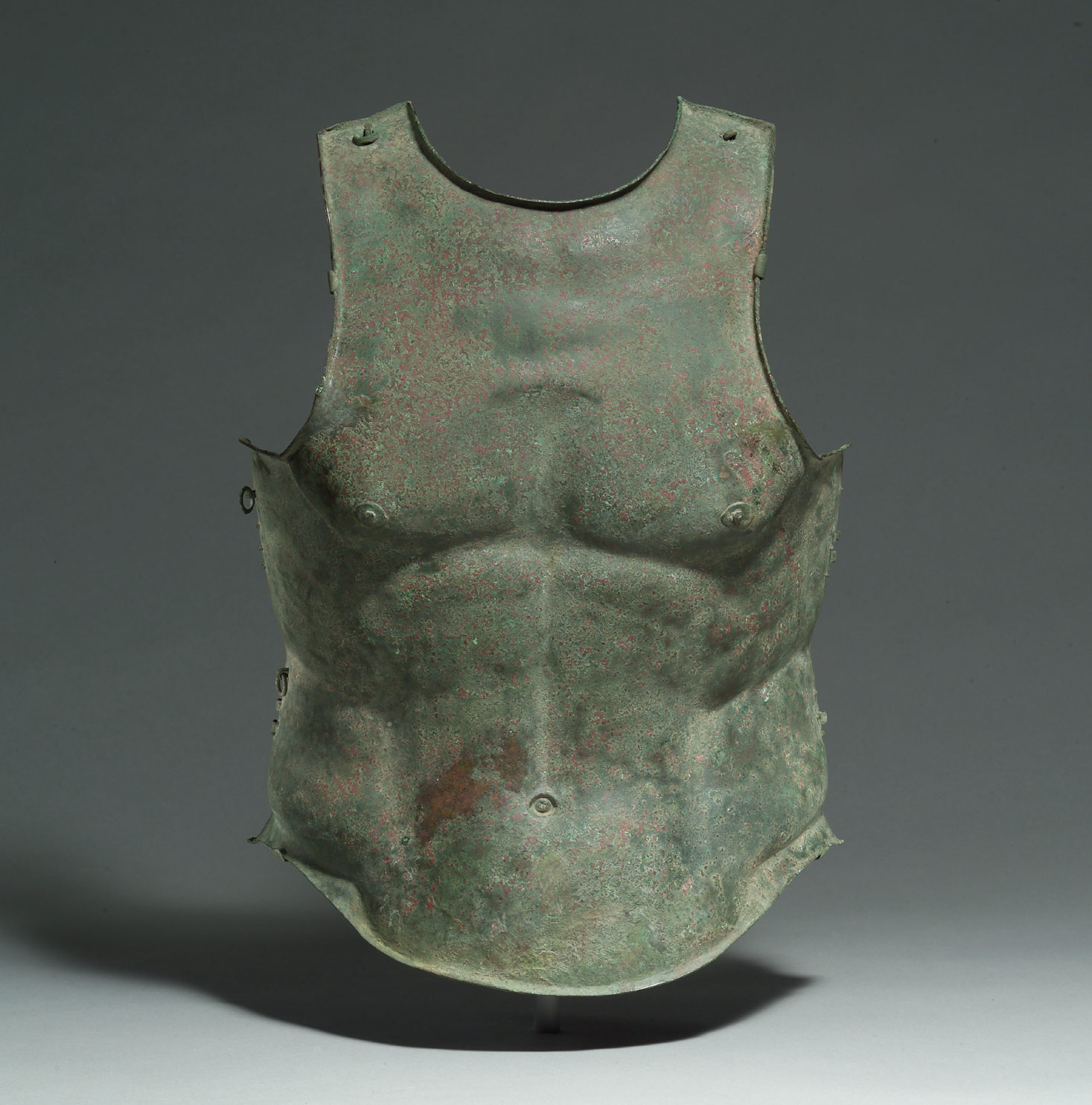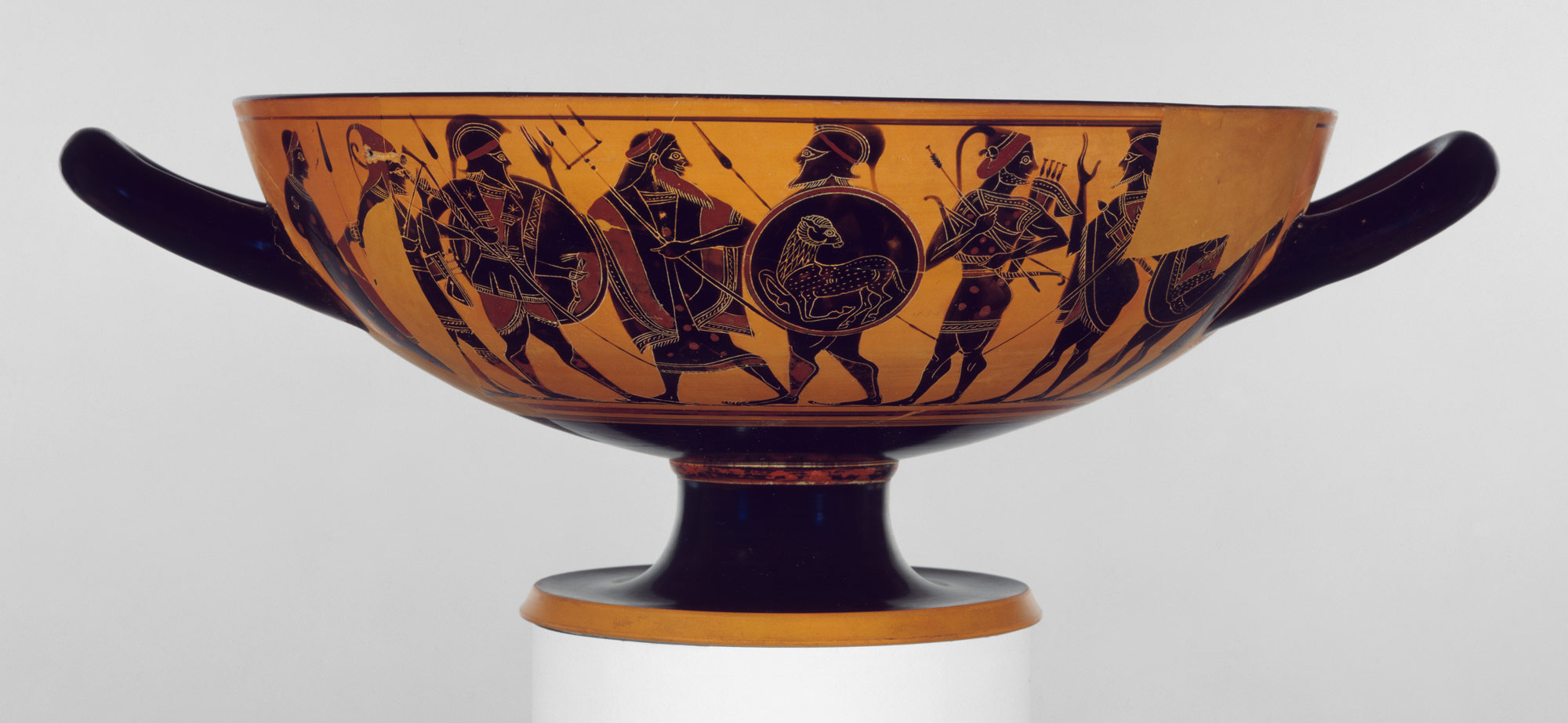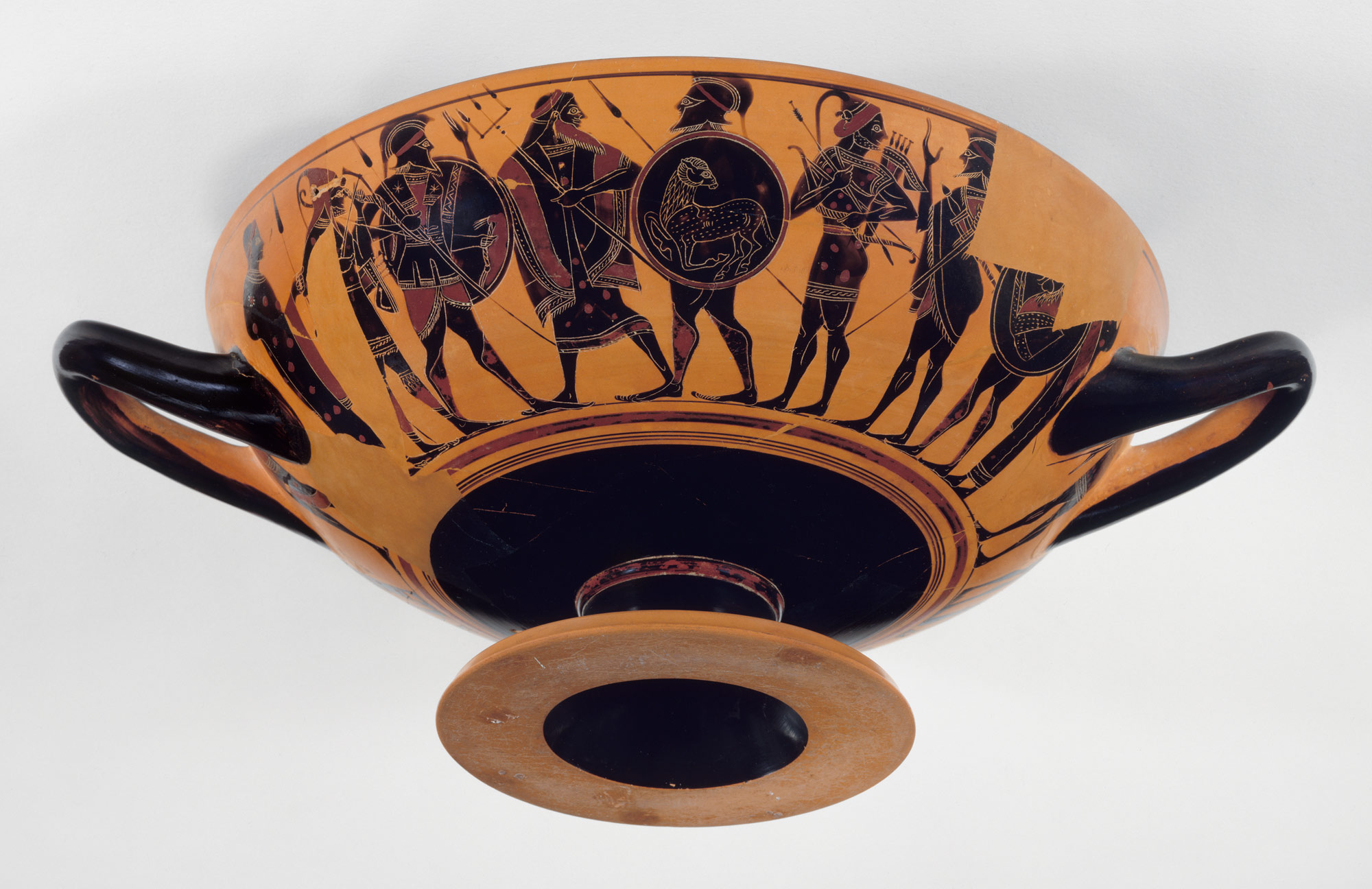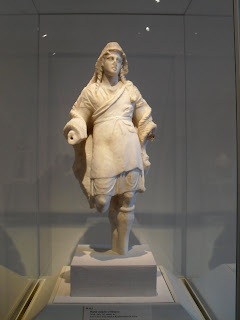This is the link to my museum report
http://zeus-shengyu.blogspot.com/2010/03/museum-report.html
Thursday, March 25, 2010
Wednesday, March 24, 2010
Metropolitan Museum - Greek Armor


Greek Armor is one of the subjects that caught my attention the most as I read the story of the Iliad which mentioned how physical and tasking the job of the soldiers was. The descriptions about the bloodiness of the battles are something that engaged me as the reader into the story and made me think about the seriousness of how critically important it was to have outstanding battle skills, strength and nevertheless a great armor at the time.
On my visit to the Metropolitan Museum I found many types of armor, from medieval European to Asian Samurai, and among these, the Greek armor. The Greek armor was composed of body armor, helmets, swords, spears, shields, axes, other bloody weapons, and a few extra gears. The very few pieces that I found were helmet and body armor.
The body armor is one of the most interesting as it is made of very detailed rendering of the body on metal, specifying the contour of the chest and muscles shape of a real person. It is composed of two meticulously made metal plates with the composition of the male torso; one plate covered the front and the other the back, compressing around the mid section of the body and aligning itself perfectly to the soldier’s physique. The material used for the construction of the item shown in the picture is bronze. Bronze it is known to be harder and more durable than iron and brass therefore it was an excellent choice for weapons and protection at the time. According to the MET museum, this item was made in the 4th century B.C. by a metalworker named Pistias whose “customers stressed their need for a proper fit and were willing to pay the price for it”.
Each piece was literally a work of art taken to battle to fight the enemy in style. In present time when have we seen so much attention given to the decorations on a weapon? If one looks closely to the images one can see how elaborated the decoration on these items is.
The helmet, a 7th century B.C. piece made out of bronze is “is a modification of a Corinthian type, having a profiled cheekpiece and lacking the usual long nose guard” that other helmet of the time used to have, as Metropolitan Museum describes it. On the helmet we can see encrypted images all around. The image shown on the helmet is a standing lion. This creature was symbolic and was supposed to bring calmness and strength to the warrior in the battle. I also found that these well-decorated pieces might also have being subjects of dedication to Greek sanctuaries.1
The dedication placed into the making of these pieces doesn’t fall short of making them a work of art, along with the different armor from other eras that is shown in the Metropolitan Museum. This is something that needs to be seen in person to be fully appreciated.
On my visit to the Metropolitan Museum I found many types of armor, from medieval European to Asian Samurai, and among these, the Greek armor. The Greek armor was composed of body armor, helmets, swords, spears, shields, axes, other bloody weapons, and a few extra gears. The very few pieces that I found were helmet and body armor.
The body armor is one of the most interesting as it is made of very detailed rendering of the body on metal, specifying the contour of the chest and muscles shape of a real person. It is composed of two meticulously made metal plates with the composition of the male torso; one plate covered the front and the other the back, compressing around the mid section of the body and aligning itself perfectly to the soldier’s physique. The material used for the construction of the item shown in the picture is bronze. Bronze it is known to be harder and more durable than iron and brass therefore it was an excellent choice for weapons and protection at the time. According to the MET museum, this item was made in the 4th century B.C. by a metalworker named Pistias whose “customers stressed their need for a proper fit and were willing to pay the price for it”.
Each piece was literally a work of art taken to battle to fight the enemy in style. In present time when have we seen so much attention given to the decorations on a weapon? If one looks closely to the images one can see how elaborated the decoration on these items is.
The helmet, a 7th century B.C. piece made out of bronze is “is a modification of a Corinthian type, having a profiled cheekpiece and lacking the usual long nose guard” that other helmet of the time used to have, as Metropolitan Museum describes it. On the helmet we can see encrypted images all around. The image shown on the helmet is a standing lion. This creature was symbolic and was supposed to bring calmness and strength to the warrior in the battle. I also found that these well-decorated pieces might also have being subjects of dedication to Greek sanctuaries.1
The dedication placed into the making of these pieces doesn’t fall short of making them a work of art, along with the different armor from other eras that is shown in the Metropolitan Museum. This is something that needs to be seen in person to be fully appreciated.
Works Cited
Cuirass (Body Armor) [Greek, Apulian] (1999.36.3.3), The Metropolitan Museum of Art. Personal photograph by author. March 2010.
Helmet [Greek, Cretan] (1989.281.49), The Metropolitan Museum of Art. Personal photograph by author. March 2010.
1 "Helmet [Greek, Cretan] (1989.281.49)". In Heilbrunn Timeline of Art History. New York: The Metropolitan Museum of Art, 2000–. http://www.metmuseum.org/toah/works-of-art/1989.281.49-.50 (March 2010)
Monday, March 22, 2010
Visit to the Metropolitan Museum
The visit to the museum was more exciting than what I personally expected. In my case I have never been attracted to visiting museums, and for this project I even thought I was going to have a boring time looking at objects from the far past. But, surprisingly it was a very enriching experience for me. As soon as I entered the Greek gallery I literally felt that I travelled in time. Just by being surrounded by objects that were actually used centuries ago made me feel that I was actually there and gave me a much better sense of the history behind them.

The first object that caught my attention and actually I never thought I would have the chance to be in front of was a Greek warrior's body armor. The first thought in my mind was the name of Greek war heroes such as Achilles, Ajax, Odysseus, etc. I took a closer look to the armor and I found small details engraved in the chest armor and helmet that would be the envy of modern art. My question immediately was "How did they make it back in that time"?

The next interesting piece of art I saw not only for its perfection but also for its significance behind in the Greek culture of the time was the sculpture of a real size lion. The figure had its body in a "ready to attack" posture. I always saw the same body language in all lions that I saw. Then I asked myself the meaning of it. I found out that the lion was used as the symbol of battle strength, tenacity, and also it was used as a "tomb guardian" figure.

I never saw a genuine representation of God Zeus, but it looked very close to how I imagined. I saw an sculpture of his face, and to me he looked concerned, not as old rather young to be the maximum authority of the Greek gods.

I literally travel in time when I encountered a monumental Greek palace column right in the middle of the room where all entrances led all visitors to, as if we the visitors were entering through the gates of Greece. When I stood in front of it my imagination instantly transported me to a Greek island making me feel that I was in the middle of it having the sea as background.

The next article that got my attention was a very small but significant engraving in stone representing one of the critical moments in the progressive revelation of Odysseus. It was the equivalent of a picture in modern times. It was an engraving of Odysseus who's feet were being washed by a nurse, in front of his wife and son. This part would be more involved with the Odyssey really but I thought it was worth mentioning anyways.
I also saw a group of very interesting sculptures, such as the Trojan Horse, the god Eros, and the image of the messenger of the gods Hermes. Even though we didn't talk about these figures in detail in class, I did remembered that they were mentioned briefly in some lectures and passages while we read the story.

The visit to the museum was more exciting than what I personally expected. In my case I have never been attracted to visiting museums, and for this project I even thought I was going to have a boring time looking at objects from the far past. But, surprisingly it was a very enriching experience for me. As soon as I entered the Greek gallery I literally felt that I travelled in time. Just by being surrounded by objects that were actually used centuries ago made me feel that I was actually there and gave me a much better sense of the history behind them.

The first object that caught my attention and actually I never thought I would have the chance to be in front of was a Greek warrior's body armor. The first thought in my mind was the name of Greek war heroes such as Achilles, Ajax, Odysseus, etc. I took a closer look to the armor and I found small details engraved in the chest armor and helmet that would be the envy of modern art. My question immediately was "How did they make it back in that time"?

The next interesting piece of art I saw not only for its perfection but also for its significance behind in the Greek culture of the time was the sculpture of a real size lion. The figure had its body in a "ready to attack" posture. I always saw the same body language in all lions that I saw. Then I asked myself the meaning of it. I found out that the lion was used as the symbol of battle strength, tenacity, and also it was used as a "tomb guardian" figure.

I never saw a genuine representation of God Zeus, but it looked very close to how I imagined. I saw an sculpture of his face, and to me he looked concerned, not as old rather young to be the maximum authority of the Greek gods.

I literally travel in time when I encountered a monumental Greek palace column right in the middle of the room where all entrances led all visitors to, as if we the visitors were entering through the gates of Greece. When I stood in front of it my imagination instantly transported me to a Greek island making me feel that I was in the middle of it having the sea as background.

The next article that got my attention was a very small but significant engraving in stone representing one of the critical moments in the progressive revelation of Odysseus. It was the equivalent of a picture in modern times. It was an engraving of Odysseus who's feet were being washed by a nurse, in front of his wife and son. This part would be more involved with the Odyssey really but I thought it was worth mentioning anyways.
I also saw a group of very interesting sculptures, such as the Trojan Horse, the god Eros, and the image of the messenger of the gods Hermes. Even though we didn't talk about these figures in detail in class, I did remembered that they were mentioned briefly in some lectures and passages while we read the story.

Wednesday, March 10, 2010
Antigone
It makes you wonder how much more improved the play would have been if it had been acted out to the full extent of the story. It gives a different perspective to those who have read the play. What you imagined may have looked completely different acted out.
On a side note, does anyone remember the scene where the chorus was walking around in circles and what it might represent?
Tuesday, March 9, 2010
Great Works Series, Antigone
After viewing today's performance, there was one question that i still had that went unanswered. When a text is adapted for use in the theater, I know that most performances have to be reviewed to ensure that they keep the integrity of the work intact. I know for a fact that this is true with modern performances, my question is who ensures the integrity of the Great Works of Literature including Antigone?
Friday, March 5, 2010
During my visit to the MET, I visited the Greek and Roman arts gallery. There were lots of pottery, sculptures, jewelry, and even coins but the things that interested me most were the armors and battle gear. It made me feel as if the Greeks were obsessed with the body. The armors were created with such detail that they seemed more like fancy outfits for a formal event rather than pieces of protective covering meant to keep someone alive in battle.
 Many of the armors were like the one in the picture above - made with amazing detail, right down to the nipple and the curve of every muscle. As I walked through the gallery I also noticed that most of the pottery depicted some sort of battle or event involving some feat requiring incredible strength.
Many of the armors were like the one in the picture above - made with amazing detail, right down to the nipple and the curve of every muscle. As I walked through the gallery I also noticed that most of the pottery depicted some sort of battle or event involving some feat requiring incredible strength.

 The pictures above are of a cup which depicts part of the thirteenth book of the Iliad. I didn't take any pictures of my own but there were also multiple cups and/or vases showing "Herakles" or Hercules battling a sea-monster or on some other quest.
The pictures above are of a cup which depicts part of the thirteenth book of the Iliad. I didn't take any pictures of my own but there were also multiple cups and/or vases showing "Herakles" or Hercules battling a sea-monster or on some other quest.
At the end of the day, one thought I had was that not much has changed since those times. Even in today's society the beauty of the body still runs rampant as seen in Abercrombie & Fitch and or [insert popular clothing brand] ads.
[NOTE: I do not take any credit for the posted pictures, they were found on http://www.metmuseum.org/]
 Many of the armors were like the one in the picture above - made with amazing detail, right down to the nipple and the curve of every muscle. As I walked through the gallery I also noticed that most of the pottery depicted some sort of battle or event involving some feat requiring incredible strength.
Many of the armors were like the one in the picture above - made with amazing detail, right down to the nipple and the curve of every muscle. As I walked through the gallery I also noticed that most of the pottery depicted some sort of battle or event involving some feat requiring incredible strength.
 The pictures above are of a cup which depicts part of the thirteenth book of the Iliad. I didn't take any pictures of my own but there were also multiple cups and/or vases showing "Herakles" or Hercules battling a sea-monster or on some other quest.
The pictures above are of a cup which depicts part of the thirteenth book of the Iliad. I didn't take any pictures of my own but there were also multiple cups and/or vases showing "Herakles" or Hercules battling a sea-monster or on some other quest.At the end of the day, one thought I had was that not much has changed since those times. Even in today's society the beauty of the body still runs rampant as seen in Abercrombie & Fitch and or [insert popular clothing brand] ads.
[NOTE: I do not take any credit for the posted pictures, they were found on http://www.metmuseum.org/]
The Evolution of Books
Thought I should share this interesting article from the wall street journal. It gives a little insight on the evolution of books and the invention of the alphabets from ancient Mesopotamia.
http://online.wsj.com/article/SB10001424052748704548604575098611581995840.html?KEYWORDS=The+Bible+of+Bibliomania
http://online.wsj.com/article/SB10001424052748704548604575098611581995840.html?KEYWORDS=The+Bible+of+Bibliomania
Thursday, March 4, 2010
Museum Project - Ancient Greece

I went to The Natural History Museum and saw the Ancient Greece section. I was particularly interested in the Greek Mythology section. The
picture on the right is a sculpture of a pomegranate. A pomegranate i
s considered the fru
it of the Underworld and the story of Hades and Persephone, which is my favorite myth. The visit gave me a different picture of the Gods. When you hear a myth you imagine the figures in certain ways. When I saw the sculptures of the different Gods, I was surprised to see how the Greeks pictured them. The picture on the bottom left show Dionysos, the God of wine and ecstasy. I pictured shorter, slightly rounder, the image of a drunk.

At the time I was also reading the Iliad, and there was a section of war
items that reminded me of the book. There were shields, armor, and other weapons of ancient Greece. What struck out to me was the head shield. It was the same one that I picture while reading the Iliad.

Tuesday, March 2, 2010
The wisdom of socrates
Is Socrates wise to choose death over exile? What kind of Greek figure is the Greek philosopher, compared to the heroes of the Iliad and The Odyssey, epic poems that are mentioned several times in the Apology?
Subscribe to:
Comments (Atom)

